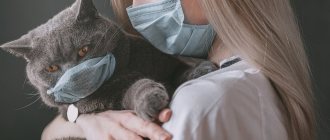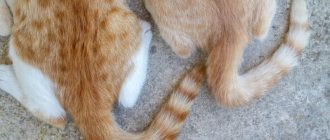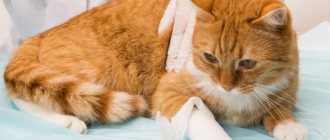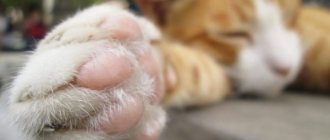The appearance of black dots that look like dirt on a cat's chin indicates the development of acne. Sometimes pathogenic bacterial microflora is involved in the process and inflammation occurs, pustules with pus are formed. To prevent the development of such pathologies, owners should be aware of measures to prevent the appearance of black spots on a cat’s chin, as well as methods of treating them.
Definition of disease
Acne is a multifactorial pathology in which comedones (blackheads) form on the skin of a cat’s chin. These formations occur with increased secretion of the sebaceous glands in conjunction with a disruption of the keratinization process in the stratum corneum of the epidermis.
Acne affects cats of any gender, age and breed, regardless of the conditions of detention.
There is no single cause for the appearance of blackheads in cats. Predisposing factors for their formation include non-compliance with basic rules of care and nutrition, stress, infectious and parasitic diseases.
Note! According to statistics, neutered pets practically do not get acne.
How to distinguish acne from other pathologies
It is important to be able to distinguish black dots from waste products of blood-sucking parasites and their larvae, as well as from droplets of dried blood that could appear as a result of trauma to the skin. Differentiating one condition from another is quite simple. You need to carefully try to detach the black lump. If it comes off easily from the skin and is dark brown in color, then it is dried blood.
Dried blood on a cat's chin looks like inflammation of the sebaceous glands
It is important to inspect the surface for scratches and small wounds. If the black dot has separated from the skin, but has a dense consistency and is difficult to press, then most likely these are waste products of ticks or fleas. Less commonly, these can be larvae of blood-sucking parasites. Acne is indicated by the inability to separate the blackhead from the skin. At the same time, it is as if soldered into the mouth of the sebaceous gland.
Flea larvae in cats can be confused with blackheads
If, in addition to acne, the animal has other symptoms, such as lethargy, appetite disturbances, diarrhea, then you should definitely consult a doctor.
Causes and mechanism of disease development
The reason for the failure of the keratinization process of epidermal cells in cats has not been established. Therefore, experts identify several factors that contribute to this phenomenon and lead to the appearance of black spots on the fur of cats. These include:
- increased secretion from the sebaceous glands of the epidermis;
- sticking of food debris to the beard or skin on the cat’s chin;
- decreased immunity after severe infectious diseases, as well as during the rehabilitation period after injuries or operations;
- dysfunction of the endocrine glands;
- intoxication phenomena caused by diseases of the gastrointestinal tract, liver and pancreas;
- allergic reactions;
- skin pathologies;
- dermatophytoses;
- demodicosis;
- improper care of the animal's skin and fur;
- some infectious and parasitic diseases;
- severe or prolonged stress.
Important! Owners must carefully monitor the cleanliness and integrity of the dishes from which the animal eats and drinks. Pathogenic microorganisms accumulate in chips, scratches and cracks, then enter the pet’s skin and can easily provoke inflammation and cause sores on the chin of cats.
The mechanism of comedones formation in cats occurs in 5 stages:
- Increased secretion from the sebaceous glands (sebum).
- Blockage of the ducts of the sebaceous glands with a mixture of sebum and dead epithelial cells.
- Formation of open cysts (comedones) at the mouth of the hair follicle.
- Oxidation of the contents of comedones in the presence of oxygen. Visually, this is marked by the appearance of black dots on the cat’s skin.
- Opening of comedones.
If comedones open into the external environment during injury by an animal, infection occurs and purulent inflammation develops. But sometimes cysts greatly increase in size, become inflamed and open into the dermal cavity. In this case, surrounding tissues are involved in the process. The cat's immune system tries to prevent the spread of pathogenic microflora and releases a huge number of white blood cells. When they die, they form purulent exudate, which accumulates in the internal cavity and then tends to come out. Clinically, this is manifested by the formation of abscesses, severe itching and even pain. Scratching the abscess leads to secondary infection, the formation of non-healing ulcers, which, when dry, form scabs on the cat’s chin.
Important! Attempts by cat owners to open comedones or abscesses on their own without following antiseptic rules often lead to re-infection and the development of complications.
Mr. Cat recommends: is there a danger to humans?
With any illness in an animal, there is a danger of infection and fear for the household. But in the case of cat acne, there is no need to worry - this pathology is absolutely safe for people. Caring for a sick animal will not bring any harm to a person.
Acne occurs for a number of reasons; this disease is not viral. Even small children, the elderly and people with a low immune background will never get acne from a sick cat.
Read the article about what a person can actually get infected from a cat.
Clinical symptoms
Sores in cats are localized mainly on the lower jaw. Sometimes, in addition to the beard, black specks can be found along the line of the upper and lower lips.
At the first stage of the disease, clinical symptoms are noticeable only in hairless cats in the form of small dirty dots. In 50-55% of cases, no further development of pathology occurs, and the animals do not show concern.
In 45% of cases, feline black comedones on the cat's chin progress to sores such as papules and pustules. Their symptoms are:
- the appearance of red spots on the skin of the chin;
- formation of painful tubercles;
- the appearance of a spherical or cone-shaped abscess, upon pressing on which a certain amount of purulent exudate is released.
If squeezing out the abscess and its subsequent treatment was carried out in compliance with antiseptic rules, then after 2-3 days a dry crust appears in place of the pustule. After its removal, no scars remain.
However, quite often the cat scratches the abscess on its own, which provokes the development of a secondary infection and the formation of a boil. Clinically this manifests itself:
- hyperemia and swelling of the chin tissue;
- an increase in local temperature;
- itching and soreness, which provoke further scratching;
- thickening of the skin in the lower jaw area.
After the completion of the process of maturation of the boil and the formation of a connective tissue capsule around it, pain and itching go away, the temperature returns to normal, and the purulent exudate is visible through a thin layer of skin.
Treatment with home remedies
In the mild, initial stages of the disease, the problem can be dealt with using home and folk remedies. Do not forget that acne treatment must be agreed upon with a veterinarian.
Sometimes treating blackheads with a two-phase makeup remover helps. By carefully blotting with a cotton swab moistened with the product, excess sebum and dirt are removed from the affected areas, and the skin is disinfected.
It is important to remember that this method can only be used in the absence of ulcers and inflammation.
If the nature of the disease is allergic, then changing the food or replacing plastic dishes with metal and earthenware usually helps.
If there are no ulcers, inflammations, or infected wounds, the use of folk remedies is acceptable. For example, lubricate acne with a mixture of two Furacilin tablets and chamomile decoction or fresh pumpkin juice. If there are a small number of blackheads and no pustules, lotions made from celandine infusion or yarrow decoction can also help.
Diagnosis
In order to correctly prescribe treatment, a veterinarian must make an accurate diagnosis and find out the causes of the black spots on the cat’s chin. This can be done based on clinical and laboratory studies.
First of all, the doctor pays attention to the presence of black spots or spots on the cat’s chin. Next, he makes a scraping from the skin and sends it to the laboratory to exclude dermatomycosis and parasitic diseases (demodex).
If a cat has purulent sores on the chin near blackheads, then a veterinarian will conduct a cytological analysis of the epidermis for the presence of pathogenic microflora.
Symptoms
After detecting acne, it is recommended to examine your pet for other abnormalities:
- bald spots - bald areas;
- swelling of the body, edema;
- hyperemia of the skin;
- pimples, the number of which increases over time.
Changed behavior is also a warning sign. If the animal is constantly itching, then black spots in the cat's fur are accompanied by itching on the neck.
Treatment of black spots on a cat's chin and prognosis
It is not advisable to treat acne at the comedonal stage (when single black dots are visible on the cat’s chin), since therapy is required only at the stage of pustules or boils. The veterinarian informs the owner about this and gives him clear instructions regarding further monitoring of the disease.
The opening of the boil is carried out only after the formation of the connective tissue capsule. When trying to squeeze out an immature abscess in a cat, pathogenic microorganisms can enter the systemic bloodstream and cause sepsis.
Important! To eliminate the pathology, complex treatment is necessary, which includes local and systemic therapy. If deep boils are present, surgery may be necessary.
Local therapy
First, the hair on the chin of a kitten or adult cat is trimmed. Further treatment is carried out according to the following scheme:
- daily cleansing of the skin with antiseborrheic shampoos, which contain salicylic alcohol or ethyl lactate (used until the clinical manifestations of the disease disappear);
- treatment of the affected area with a 1% chlorhexidine solution;
- lubricating acne with antibacterial ointments or lotions.
Important! After eliminating the clinical signs of acne, doctors recommend continuing to treat the skin with antiseborrheic shampoos 2 times a week for a month to prevent the development of relapses.
Systemic treatment of black spots on the chin of a cat
In the presence of secondary infection, antibiotic therapy is carried out. Medicines are selected taking into account the results of a cytological study. To eliminate severe itching, a specialist may prescribe steroid drugs, the dosage and course of use of which is determined individually for each animal. Also, foods containing essential fatty acids must be included in the cat’s diet.
Despite the favorable prognosis of treatment, most cats experience relapses over time. Therefore, if the owner notices that spots similar to dirt have appeared on the cat’s chin, he should contact a veterinary clinic as soon as possible. Such blackheads are a consequence of metabolic disorders caused by various factors. Untimely treatment leads to their proliferation, enlargement and infection with pathogenic pyogenic microflora. Self-treatment of acne in cats is contraindicated, as it requires the use of antibacterial and steroid drugs, which can only be prescribed by a veterinarian.











